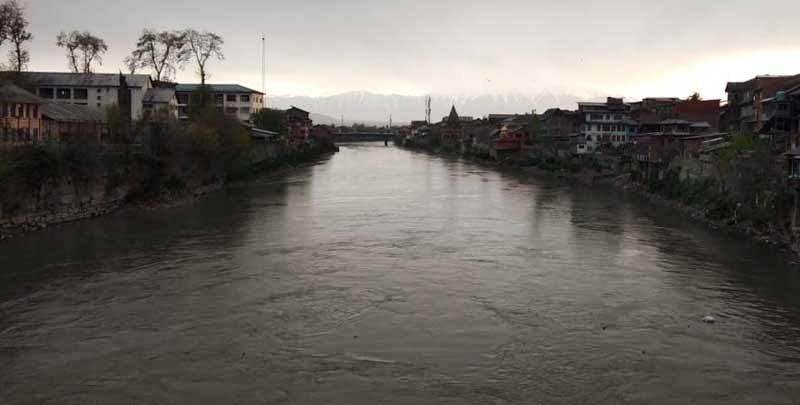
Srinagar- Urbanisation, unabated encroachment and flow of sewage are the reasons the river Jhelum is getting polluted, experts said.
Jhelum which originates from Verinag in south Kashmir and traverses through Srinagar before entering into Wular Lake is an important source of irrigation, drinking water and hydropower in the valley.
Experts said the heaps of garbage, polythene, plastic and even pipes dropping sewage into the river are a common sight due to which this river has been turned into a big drain of Kashmir.
They said the majority of the population here is dependent on Jhelum for drinking water purposes but the pollution of this water body has become a reason for many diseases.
An official of the Pollution Control Board said that urbanisation and encroachment of the banks of Jhelum have led to tonnes of solid and liquid waste from home toilets into the water body. This not only deteriorates the water quality but also adversely impacts the aquatic life of the river, he said.
Another official said that slaughterhouse owners located on the banks of Jhelum are also draining the waste of slaughtered animals into it. “We do not have any holistic sewerage project even in Srinagar,” he said.
There are dozens of towns in Anantnag, Bijbehara, Awantipora, Pampore and Srinagar city located on the banks of Jhelum which have led to the encroachment and ultimately polluting the water body by draining waste into it, he added.
“Jhelum is our lifeline. If it is damaged beyond repair, it will badly impact each and every sector of life in Kashmir,” the official said, adding that the river provides livelihood to many fishing populace of Kashmir.
The pollution control board official said that fast urban growth coupled with intensified agricultural practices, and disposal of municipal drainage and sewage has altered the aquatic ecosystem in the Jhelum, which has resulted in an alarming increase in eutrophication and pollution level of the water body.
“The garbage of all sorts, including animal carcasses and plastic bottles, get stuck under bridges. From industrial wastes produced by hotels and factories to household garbage, plastics and all kinds of scrap material left behind by the unmindful construction activities, everything seems to be finally finding its way into the river Jhelum,” he said.
“The cost of fiddling with nature and mistreatment of Jhelum was there for all to see in 2014 when the fury of flood caused destruction all around. Nearly nine years have passed since the floods nearly wiped off Srinagar from the map, but very few lessons have been learnt.”
The research “Massive land system changes impact water quality of the Jhelum in Kashmir Himalayas,” published by Prof Shakil Ahmad Romshoo and others, to assess the changes in water quality from 1983 until 2016 shows an increase of nitrate-nitrogen in the river.
The concentration of nitrate-nitrogen in the river has increased from 185 to 672µgL-1, indicating an increase of 260 per cent over the years. It has happened due to the combined impact of urbanization, reckless application of pesticides and fertilizers, forest degradation and deforestation.
In a recent study, the turbidity level in the water of Jhelum has been found higher than permissible limits.
The permissible turbidity level of the Jhelum is 1.0-5.0 N.T.U while turbidity at Verinag has been found 0.9 while at Anantnag it is 9.8, 12.1 at Padgampora Pulwama, 12.6 at Larkipora Pulwama, 13.1 at Awantipora, 15.9 at Barsoo and 19.7 at Srinagar.
The Central Pollution Control Board (CPCB) last year declared four water bodies including Jhelum polluted based on Biological Oxygen Demand (BOD) indicating organic pollution.
The CPCB data had suggested that the entire stretch of Jhelum from Srinagar to Baramulla is polluted. The BOD level in Jhelum has been recorded at 7.8 and it falls in the priority class four. The officials said that the restoration process of water bodies including Jhelum is going on and every effort is being made to conserve them from pollution and other things
Follow this link to join our WhatsApp group: Join Now
Be Part of Quality Journalism |
Quality journalism takes a lot of time, money and hard work to produce and despite all the hardships we still do it. Our reporters and editors are working overtime in Kashmir and beyond to cover what you care about, break big stories, and expose injustices that can change lives. Today more people are reading Kashmir Observer than ever, but only a handful are paying while advertising revenues are falling fast. |
| ACT NOW |
| MONTHLY | Rs 100 | |
| YEARLY | Rs 1000 | |
| LIFETIME | Rs 10000 | |













